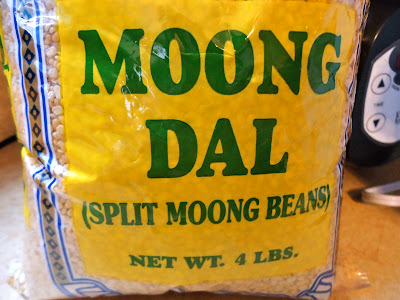 |
| Moong Dal (Split Moong Beans) For the Dhuli Moong Dal in Anupy Singla's "The Indian Slow Cooker" book. |
 |
| Simplest of Simple Yellow Lentils |
This dish is called "Simplest of Simple Yellow Lentils" or Dhuli Moong Dal. I show you the picture of the package and the beans because I think that they are referred to as peas, lentils & beans!! If you are trying to buy the exact ingredient called for, then look for "Moong Dal". They are not what we usually see at Whole Foods as "Peas", or "Yellow Lentils". As far as I can tell, they are the yellow variety of the "Mung" bean. "Mung" is how it is labelled at Whole Foods & Sprouting seeds. "Moong" is how it is labelled in International Stores. Of course, either will work, but what in the States we traditionally call green or yellow peas/lentils may take a different cooking time & would produce a slightly different texture. When I used to make similar dishes in the pressure cooker, I always had used split yellow peas before, but it never seemed to be the same texture as the restaurant. This seems to have been remedied by taking care to buy the exact legume called for in the recipe!! It's going to turn out either way, but I was just trying to understand all of the "bean" terminology. These split mung (moong) beans are pretty small so they do create a slightly different texture in the end.
It's funny that it is called "Simplest" of Simple Yellow Lentils, because all of Anupy's recipes have been pretty simple so I couldn't imagine how much easier it could be. You put everything in the pot and push a button. The most effort you exert is to cut and onion. I used the correct bean and the correct amount of water and this is a "soupier" texture, which I love. Just in case you make it and are wondering if it is supposed to be very thick or thinner to put over rice. When it was immediately finished it created a beautiful soup, and by the next day it had thickened quite a lot. Perfect alone in a bowl, or over some brown basmati rice.
 |
| Yellow Moong Dal |
 |
| Tomato, Ginger, Garlic, Fresh Chili, Cumin, Tumeric, Red Chili Powder. Everything on this plate has healing potential! And metabolism boosting properties. |
 |
| All ingredients in the Slow Cooker, prior to adding the water. |
 |
| About 1/2 way through cooking. |
Another hit in our Indian Slow Cooking journey. This dish is so easy, with such basic ingredients, that it's pretty easy to have all the stuff you need on hand anytime. I didn't have fresh cilantro so I skipped it that day. Sometimes I don't have fresh tomato so I either use a little tomato paste or just skip it. Ginger I buy in bulk and keep it in the freezer. I just grate it when I need it and return to the freezer. The dried beans keep nearly forever on the shelves. And Spices and Garlic are pretty basic and easy to keep on hand. And these are pretty basic spices, so even if you don't venture outside of really basic tastes, it is highly probable that you have things like cumin, chili powder and tumeric already in your spice rack!
by: Anupy Singla
Mandatory for Fans of Indian Cuisine.
Perfect marriage of Simplicity & Spice.
Remember this book is written for "homestyle" Indian, which means it's for spicy boys and girls! I am a very spicy girl, so I don't alter the recipes at all. However, Anupy suggests following her lead if you have various levels of spicy people living under one roof. Just make 2 batches of food, one spiced mildly and one for people who like to sweat. Split the recipe and put them in 2 different slow cookers. You know you need another slow cooker anyway, right? I mean, how are you going to make that basmati rice pudding to eat after your Simple Yellow Lentils anyhow?
Have you guys made any of the recipes from this book yet?



This looks so good! I am a total outsider to Indian food (with the exception of Naan bread) but because of my love of lentils, I think I might have to pick up this book! Love your blog btw - and thanks for stopping by mine! :)
ReplyDeleteI love this book! This is the dish I started with, I made it with split red lentils because I hadn't found any moong dal yet. I too am a little confused over the terminology of the beans/peas/lentils, but whatever! It's all delicious. :)
ReplyDeleteYes....the terminology is different. Well, for me anyhow. I am used to the word lentils meaning a "lens" shape, or flatter legume. What I have found though, is to read the "indian name" for each bean and look for those packages, to learn to identify them. Generally beneath the title, the Indian name is listed. I actually took the book with me the first few times......
ReplyDelete